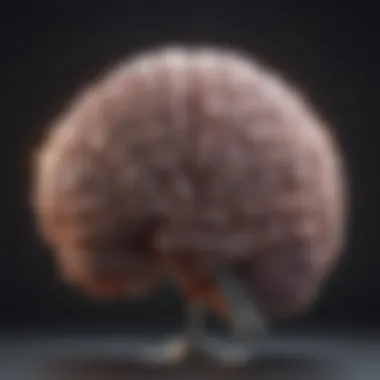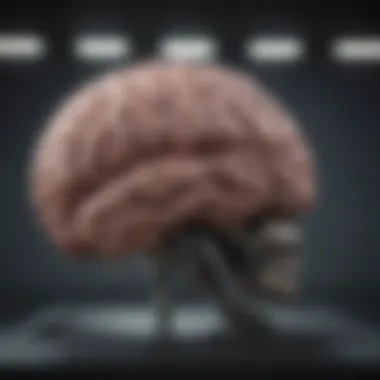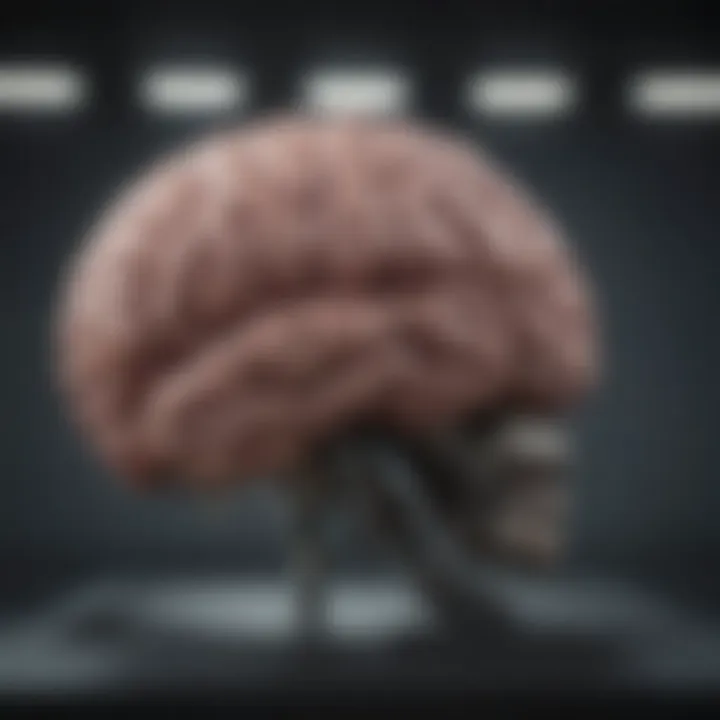Understanding Brain Study Tests: A Comprehensive Exploration


Intro
Brain study tests are invaluable tools employed in both clinical and research settings. They help uncover the complexities of the human brain and its functions. Understanding these tests is essential for students, researchers, educators, and professionals who wish to deepen their knowledge of neuroscience and cognitive science.
In this exploration, we will address the various types of brain study tests, their methodologies, their significance in different contexts, and the ethical considerations associated with them. By outlining these aspects, we aim to provide readers with a solid foundation in understanding the importance and implications of brain study tests.
Research Overview
Methodological Approaches
There are diverse methodologies within brain study tests. These often fall into two broad categories: cognitive assessments and neuroimaging techniques. Cognitive assessments evaluate mental functions such as memory, attention, and problem-solving abilities. These assessments often utilize standardized tests to measure cognitive abilities in a controlled manner.
Neuroimaging techniques, on the other hand, visualize brain structures and activity. Techniques like functional Magnetic Resonance Imaging (fMRI) and Positron Emission Tomography (PET) allow researchers to see how different parts of the brain respond to various stimuli or tasks. This kind of analysis provides insight into the brain's operational dynamics.
Significance and Implications
Understanding brain study tests has far-reaching implications. In clinical settings, these tests assist in diagnosing neurological disorders, evaluating brain injuries, and informing treatment plans. For example, cognitive assessments can indicate levels of impairment in patients with Alzheimer's disease, guiding further management.
In research contexts, these tests shed light on cognitive processes, theories of the mind, and the effects of different variables on brain function. As such, the information garnered from these procedures plays a vital role in advancing knowledge in neuroscience and guiding future research directions.
"The brain is the seed of intelligence, the foundation of our thoughts, and the source of our actions. Understanding how it functions is critical for progress in healthcare and education."
Current Trends in Science
Innovative Techniques and Tools
Recent advances in technology have revolutionized brain study tests. Innovations such as machine learning algorithms are being incorporated to analyze data from neuroimaging, offering nuanced insights into brain activity. Additionally, the development of portable neuroimaging machines allows for testing in more varied environments, enhancing accessibility and usability.
Moreover, virtual reality (VR) is increasingly applied in cognitive assessments, enabling immersive environments that may lead to more accurate evaluations of cognitive functions. This fusion of technology and neuroscience illustrates an evolving landscape aimed at enhancing both precision and understanding.
Interdisciplinary Connections
Brain study tests are not confined to neuroscience alone; they intersect with multiple disciplines. Psychology, for instance, closely collaborates with neuroimaging to explore how cognitive processes correlate with brain activity. Similarly, artificial intelligence and software development play significant roles in analytical techniques. This multidisciplinary collaboration often leads to richer insights and more substantial breakthroughs in understanding brain function and cognition.
Preface to Brain Study Tests
Brain study tests play a crucial role in the field of neuroscience and cognitive research. They serve as essential tools for understanding the intricate workings of the brain. These tests help identify cognitive abilities, emotional states, and neurological functions. In this article, we will explore their significance, methodology, and application in both clinical and research environments.
Defining Brain Study Tests
Brain study tests encompass a range of assessments designed to evaluate cognitive, emotional, and neurological functions. These tests can include standardized tests, questionnaires, and imaging techniques. They are developed to gather data about brain activity and cognitive processes, offering insights into how individuals think, reason, and behave. Methodologies can vary significantly, from neuroimaging to self-reported surveys. This variety allows for a broader understanding of brain functions and disorders.
Importance of Brain Study Tests
The importance of brain study tests cannot be underestimated. They provide critical data that supports diagnosis and treatment of neurological disorders. For example, tests can help in the identification of conditions like Alzheimer’s disease, various forms of dementia, or traumatic brain injuries. Moreover, they offer valuable insight for researchers aiming to expand the existing knowledge of brain functions and cognitive processes. Additionally, understanding results from these tests contributes to the improvement of therapeutic interventions and helps create tailored treatment plans for affected individuals.
"Brain study tests are not only tools for diagnosis but also gateways to understanding human cognition and behavior."
Their value extends beyond individual assessments; they inform broader research outcomes and facilitate advancements in cognitive science.
Types of Brain Study Tests
Brain study tests serve as essential tools for understanding cerebral functions and diagnosing various conditions. Different types of tests offer unique insights into cognitive abilities and neurological health. Each category of brain study tests provides different methodologies and applications, making a thorough grasp of these types crucial for both scientific exploration and clinical practice.
Cognitive Assessments
Cognitive assessments play a pivotal role in evaluating mental processes, such as memory, attention, and problem-solving abilities. These assessments help in identifying cognitive impairments and tracking changes over time. They can be divided into standardized tests, clinical assessments, and self-reported measures.
Standardized Tests


Standardized tests are highly structured assessments designed to measure cognitive abilities consistently across different individuals. These tests are beneficial for establishing a reliable benchmark for comparing cognitive performance. A key characteristic of standardized tests is their ability to produce quantifiable data, which is crucial for research and clinical evaluation.
The unique feature of standardized tests is their norm-referenced nature. This means they are validated based on a large population sample, allowing for a comparison of an individual's scores against established norms. The advantages of using standardized tests include their objectivity and replicability. However, they may not fully encompass individual differences.
Clinical Assessments
Clinical assessments involve a more personalized approach to evaluating a person's cognitive function. They include interviews and observational techniques, tailored to the individual's specific context. A key characteristic of clinical assessments is their adaptability, allowing professionals to consider the patient's unique history and circumstances.
The advantage of clinical assessments lies in their capacity to capture a broader range of cognitive and emotional factors. However, their subjective nature can introduce bias, which makes it essential for practitioners to have strong analytical skills.
Self-Reported Measures
Self-reported measures gather information directly from individuals about their cognitive experiences and challenges. These assessments can provide valuable insights into how individuals perceive their mental health. A critical aspect of self-reported measures is their ability to engage individuals in their evaluation process, fostering self-awareness.
The main benefit of self-reported measures is their ease of administration and potentially lower costs. Yet, the reliance on self-reporting can lead to inaccuracies, as responses may be influenced by social desirability or memory biases.
Neuroimaging Techniques
Neuroimaging techniques provide a window into the brain's structure and function, allowing researchers and clinicians to visualize brain activity. This exploration is vital for advancing our comprehension of neurological disorders and cognitive processes. Neuroimaging methods include Magnetic Resonance Imaging (MRI), Functional MRI (fMRI), and Computed Tomography (CT) scans.
Magnetic Resonance Imaging (MRI)
Magnetic Resonance Imaging (MRI) is a non-invasive imaging modality that uses magnetic fields and radio waves to create detailed images of the brain's anatomy. MRI is particularly beneficial for studying structural abnormalities, such as tumors or lesions. Its key characteristic lies in its high resolution, which allows for the visualization of soft tissues with great clarity.
One unique feature of MRI is its ability to generate three-dimensional images, contributing to better spatial orientation in analyzing brain structures. The main advantage of MRI is its non-invasive nature and high detail, although it is typically more expensive and time-consuming compared to other imaging techniques.
Functional MRI (fMRI)
Functional MRI (fMRI) measures brain activity by detecting changes in blood flow. This technique is crucial for understanding functional connectivity and real-time brain activity during tasks. A primary characteristic of fMRI is its effectiveness in linking physical and cognitive processes.
The functionality of fMRI is its ability to assess dynamic aspects of brain activity, offering insights into how different brain regions interact during cognitive tasks. However, the complexity of interpreting fMRI data can lead to potential errors in conclusions if not analyzed properly.
Computed Tomography (CT) Scans
Computed Tomography (CT) scans combine X-ray images to create cross-sectional views of the brain. This method is particularly valuable for rapid assessment in emergency situations, such as trauma cases. The key characteristic of CT scans is their speed; producing results in a matter of minutes.
The unique feature of CT scans includes their accessibility and relative affordability. They are widely used in hospitals and clinics for initial evaluations. However, the disadvantage lies in their lower resolution compared to MRI, which can limit detailed anatomical examinations.
Electrophysiological Monitoring
Electrophysiological monitoring helps in assessing the brain's electrical activities, providing insights into neural dynamics. These methods, including Electroencephalogram (EEG) and Event-Related Potentials (ERP), are vital for diagnosing and researching various neurological conditions.
Electroencephalogram (EEG)
Electroencephalogram (EEG) records electrical activity along the scalp, reflecting brain wave patterns. This technique is instrumental for understanding sleep disorders, epilepsy, and other neurological conditions. A main characteristic of EEG is its high temporal resolution, capturing fast fluctuations in brain activity.
One unique feature of EEG is its non-invasive setup, which allows for continuous monitoring over extended periods. The primary advantage is the ability to perform real-time assessments, although the spatial resolution is limited compared to imaging techniques.
Event-Related Potentials (ERP)
Event-Related Potentials (ERP) are specific brain responses triggered by particular stimuli. This method allows for the investigation of cognitive processes, such as attention and memory, in a time-sensitive manner. A key characteristic of ERP is its direct relationship with cognitive events, providing insight into the timing of brain responses.
The unique advantage of ERP lies in its capability to discern neural processes with high temporal precision. However, like EEG, it suffers from limited spatial resolution, often necessitating complementary techniques for a more comprehensive understanding.
Methodologies in Conducting Brain Study Tests
Methodologies serve as the backbone of brain study tests. They frame how tests are designed and implemented, ensuring that the gathered data is reliable and meaningful. In neuroscience and cognitive research, a clear methodology is crucial. It not only guides researchers on how to conduct their studies effectively but also establishes the context in which results are interpreted. The significance of robust methodologies cannot be overstated, as they influence findings and ultimately shape clinical practices and therapeutic interventions.
Sample Selection and Ethical Considerations
Sample selection plays a key role in the validity of brain study tests. Researchers must choose participants who accurately reflect the population they wish to study. This might include patients with specific neurological disorders or healthy individuals for comparative purposes. However, selecting the sample is more than just a technical detail; it involves ethical considerations as well. Obtaining informed consent is paramount. Participants should be made aware of the purpose of the study, what it entails, and any risks involved. Additionally, confidentiality of participant data must be strictly maintained to protect individuals' privacy and autonomy.


"Informed consent is not just a legal requirement; it is an ethical obligation that respects the autonomy of the individual."
Issues like vulnerability also arise. Certain groups, such as children or individuals with cognitive impairments, require extra attention. Researchers must tailor their communication and sampling methods to ensure ethical compliance while gaining valuable data.
Data Collection Techniques
Data collection techniques are varied and depend on the type of brain study tests being conducted. They can range from objective measurements to subjective reports. Common techniques include:
- Behavioral assessments: These involve standard tasks aimed at measuring cognitive functions, like memory or attention.
- Neuroimaging: Techniques like MRI or CT scans provide visual insights into brain anatomy and activity during tasks.
- Physiological measures: This includes monitoring brain waves with EEG or other electrical activity to gauge brain function.
Each method has its own advantages and limitations. For example, neuroimaging offers detailed perspectives of the brain's structure, but it can be resource-intensive and may not always capture immediate changes in brain activity. Conversely, behavioral assessments are often quicker and easier to administer but can be subject to biases influenced by participants’ personal experiences.
Through thoughtful selection of data collection techniques, researchers can strengthen the reliability of their findings. Thus, choosing the right methods is closely tied to the study’s aims, emphasizing the importance of planning and foresight in research methodologies for brain study tests.
Interpreting Results from Brain Study Tests
Interpreting results from brain study tests is crucial in understanding both individual cognitive functions and broader neurological trends. The process is not straightforward. It requires careful consideration of various elements to offer accurate insights. Clear interpretation can directly impact clinical decisions or inform future research directions. The multidimensional nature of brain functions means that tests can yield a variety of outcomes, reflecting differing aspects of cognition and brain activity.
Understanding Test Scores
Test scores from brain studies can provide significant information about cognitive health and functionality. Scores can range widely, often reflecting the complexity of the brain's function. They are often presented in relation to age norms or control samples for context. Higher scores in cognitive assessments typically indicate stronger functioning in the measured area, while lower scores may suggest impaired or atypical functioning.
It is also necessary to consider the test's reliability and validity. Reliable tests produce consistent results under similar conditions, while valid tests accurately measure what they are supposed to measure. Thus, understanding the context of test scores is vital for their useful application.
Challenges in Interpretation
Interpreting results does come with challenges. It is not as simple as looking at numbers; context is critical.
Variability in Results
Variability in results can emerge from multiple sources, including individual differences, testing conditions, and methodology. This variance emphasizes the need for careful analysis. Different brains respond uniquely to stimuli and assessments, which can affect outcomes significantly. Understanding this variability can help professionals tailor approaches for diagnosis or therapy effectively. The key feature here is appreciating that variability is not inherently negative; it can inform broader trends that might lead to more personalized interventions.
Cultural and Social Considerations
Cultural and social considerations also play a role in interpreting results. Cognitive tests may not be culturally neutral. They could reflect biases in how certain populations are assessed. Acknowledging cultural differences in cognition is crucial for accurate interpretation. Recognizing the context of test scores can help mitigate misinterpretations. It highlights the need for culturally appropriate testing methods, which can lead to valid outcomes and help avoid misleading conclusions.
Understanding these considerations can lead to more equitable practices in cognitive assessments, ultimately benefiting diverse populations.
Applications of Brain Study Tests
The applications of brain study tests are extensive and impactful. They provide insights critical to both clinical and research settings. In clinical practice, these tests assist medical professionals in diagnosing various neurological disorders, guiding therapeutic interventions, and monitoring disease progression. In research, they aid in exploring the complexities of brain function and understanding cognitive processes. This section will detail these applications, emphasizing their benefits and considerations.
Clinical Applications
Diagnosis of Neurological Disorders
The diagnosis of neurological disorders is a primary clinical application of brain study tests. Neurologists rely on these assessments to identify conditions like epilepsy, Alzheimer's disease, and multiple sclerosis. The key characteristic of this diagnostic approach lies in its objective measurement of brain activities through advanced technologies such as MRI and EEG. This method provides tangible data, helping to confirm or rule out specific conditions.
The unique feature here is the ability to visualize brain abnormalities in real-time. This capability can pinpoint areas of dysfunction, which is beneficial for tailored treatments. Yet, it is not without drawbacks. The complexity of the brain means results can sometimes be ambiguous, requiring careful interpretation.
Assessment of Cognitive Impairment
The assessment of cognitive impairment complements the diagnosis of neurological disorders. These tests often involve standardized cognitive assessments, which measure memory, attention, and problem-solving abilities. This approach is popular because it offers insights into daily functioning and quality of life. One key characteristic is the broad range of tools available that cater to various demographics.
Unique to this aspect is its capacity to track changes over time. Clinicians can assess baseline cognitive function and measure deterioration or improvement. However, subjective factors may influence results, such as anxiety during testing. Hence, these assessments require careful administration and interpretation to ensure reliability and validity.
Research Applications
Understanding Brain Function


Understanding brain function is pivotal in advancing neuroscience. Research applications often involve cognitive assessments or neuroimaging techniques to explore how different brain areas contribute to specific behaviors. A key characteristic of this research is the emphasis on measuring brain responses during tasks, which helps researchers connect theory with observable outcomes.
The unique aspect of studying brain function is its application in various domains, from language processing to emotional regulation. However, researchers face challenges, such as individual variability in brain activity, which can complicate generalizations.
Studying Neuroplasticity
Studying neuroplasticity is essential to grasp how the brain adapts to changes, whether from learning, injury, or disease. This aspect relies on both observational studies and experimental interventions. It stands out because it demonstrates the brain’s ability to reorganize itself by forming new connections.
One significant feature is the implications for rehabilitation after brain injuries. Understanding neuroplasticity can lead to more effective therapies. However, there are limitations, such as the difficulty in measuring the extent of neuroplastic changes objectively.
"Brain study tests not only diagnose but also reveal the remarkable adaptability of the brain throughout a person's life."
In summary, the applications of brain study tests are multi-faceted. They play an indispensable role in both clinical settings, aiding in the diagnosis and understanding of neurological conditions, and research environments, expanding our knowledge of brain function and neuroplasticity. As such, these assessments hold considerable value in the ongoing exploration of the human brain.
Ethical Considerations in Brain Study Tests
The exploration of ethical considerations in brain study tests is essential for establishing trust between researchers and participants. These tests, which seek to understand complex neural mechanisms and cognitive processes, often involve sensitive data. It is crucial to ensure that ethical guidelines are followed meticulously to protect participants’ rights and well-being.
Consent and Confidentiality
Informed consent is a fundamental aspect of conducting brain study tests. This process ensures that participants are fully aware of the nature, benefits, risks, and procedures involved in the study. Consent should not only be obtained at the onset but should also encompass the participant's right to withdraw at any time without any penalty.
Confidentiality is equally critical. Researchers must guarantee that personal data and test results remain confidential. Identifiable information should be anonymized or securely stored to prevent unauthorized access.
Ensuring proper consent and confidentiality fosters a secure environment for research, allowing participants to trust that their private information is protected while contributing to scientific progress.
Potential Risks and Benefits
The potential risks and benefits of brain study tests warrant careful consideration. Risks might include psychological distress from revealing cognitive impairments or the invasive nature of some neuroimaging techniques. However, proper safeguards can minimize these risks.
On the other hand, the benefits of conducting brain study tests are significant. They can lead to advances in understanding neurological conditions, improving diagnostic practices, and refining treatment strategies.
Each study should weigh these factors diligently, ensuring that the potential benefits significantly outweigh any risks involved.
Future Directions in Brain Research
The exploration of brain study tests has gained significant momentum, particularly as advances in technology and methodology unfold. Understanding the future directions in brain research does not only highlight the evolving scientific landscape but also informs both practitioners and researchers about promising avenues of exploration. The relevance of this topic spans various domains, from cognitive psychology to advanced medical applications. An enhanced grasp of upcoming trends facilitates better outcomes in clinical settings and enriches academic inquiry.
Technological Advancements
Technological advancements play a pivotal role in shaping brain study tests. Innovations in neuroimaging techniques, particularly, have transformed the capabilities of researchers to explore the brain's functionalities with greater precision. For instance, developments in high-resolution Magnetic Resonance Imaging (MRI) and advancements in Positron Emission Tomography (PET) contribute to an in-depth understanding of brain structures and their interrelationships.
Moreover, the integration of artificial intelligence and machine learning into data analysis is paving the way for more accurate and personalized assessments. The use of algorithms can enhance the interpretation of complex neuroimaging data, leading to improved diagnostic accuracy.
Notably, mobile technology has also created possibilities for remote cognitive assessments, thereby widening access to brain study tests for diverse populations.
Collaborative Research Initiatives
Collaboration among research institutions, universities, and healthcare providers fosters a richer exchange of ideas, data, and findings. Collaborative research initiatives amplify the impact of brain study tests by pooling resources and expertise from different fields. Such joint efforts address more sophisticated questions about brain function and cognition.
These initiatives can take various forms, including multidisciplinary research teams and consortia that work on large-scale studies, understanding neurological conditions like Alzheimer’s and Parkinson’s disease. By engaging diverse expertise—from neuroscience to behavioral science—such collaborations can yield significant insights.
Furthermore, open data sharing platforms are emerging as an invaluable resource for researchers. They promote transparency and allow for the cross-validation of results across different studies, thereby enhancing the reliability of findings.
Research in brain studies is a continuously evolving field; adapting to advancements and collaborative efforts reinforces our collective understanding of cognitive processes.
In summary, recognizing future directions in brain research is critical. As technology continues to advance and collaboration deepens across institutions, the potential for breakthroughs in understanding brain function and health enhances. This ultimately leads to better therapeutic strategies and improved quality of life for patients with neurological disorders.
Closure
The importance of concluding an article about brain study tests cannot be understated. It serves as a final opportunity to reiterate the critical insights that have been discussed throughout the paper. By summarizing the content, readers can solidify their understanding of the intricate relationships between various types of brain tests, their methodologies, and applications in both clinical and research environments.
In addition to reinforcing knowledge, the conclusion provides several benefits. Foremost, it connects theoretical information with practical implications. For instance, the discussion of how cognitive assessments aid in diagnosis allows readers to appreciate their realities. Similarly, re-evaluating ethical considerations emphasizes the need for responsible conduct in neuroscience.
Consequently, the conclusion can address future ramifications in the field. Emerging technologies and collaborative research initiatives could pave the way for novel applications of brain study tests, thus encouraging ongoing interest in the subject. Through this reflection, the importance of continuous learning and advancement in this rapidly evolving field becomes evident.
"The study of the brain is one of the most exciting domains of scientific inquiry. It touches upon various aspects that extend beyond the laboratory."
Thus, this article aims not only to inform but also to inspire readers—students, educators, researchers, and professionals—to engage with brain study tests critically.
Summarizing Key Points
- Defining Brain Study Tests: These tests evaluate cognitive and neurological functions, providing insights into brain activity.
- Types and Methodologies: Different classifications like cognitive assessments and neuroimaging techniques highlight the diverse approaches in testing.
- Interpreting Results: Understanding test scores entails recognizing variables such as cultural contexts and individual differences.
- Applications: Brain study tests are vital in clinical diagnosis and research, offering both immediate and long-term benefits for the field of neuroscience.
- Ethical Considerations: The necessity of informed consent and handling of data underscores the responsibility researchers hold.
- Future Directions: Continuous advancements in technology and collaborative initiatives will further enhance the scope of brain study tests.



